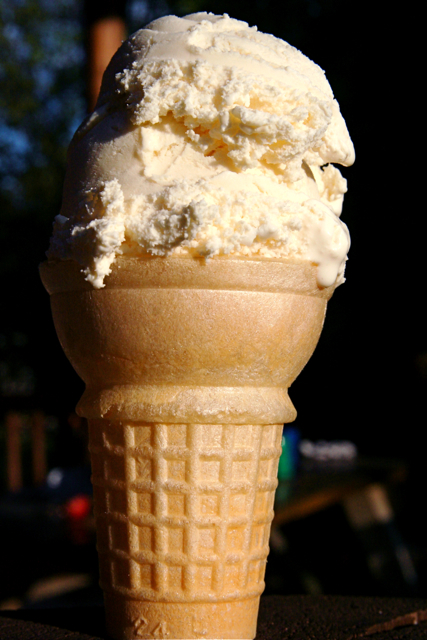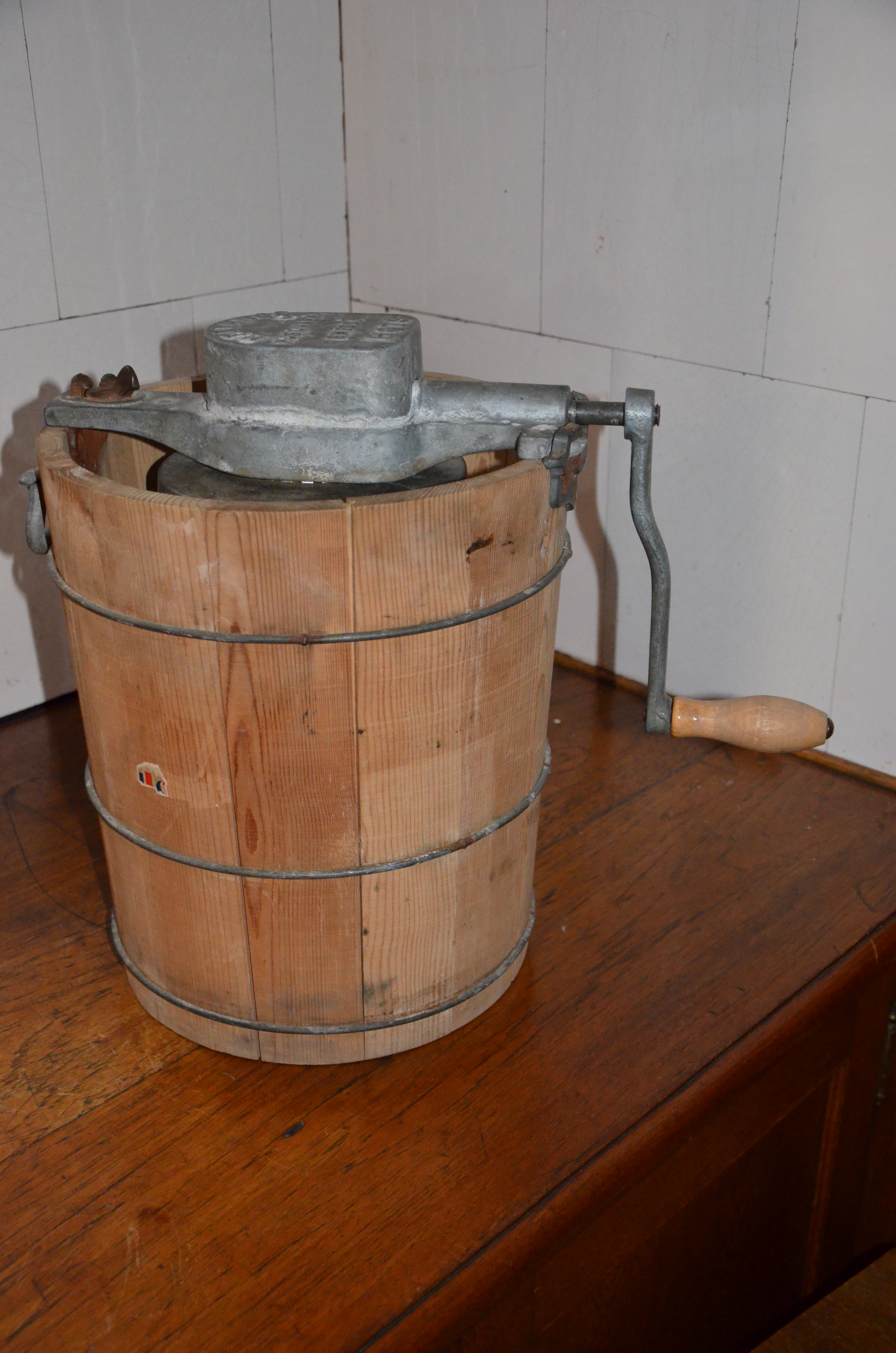Vanilla ice cream on:
[Wikipedia]
[Google]
[Amazon]






Vanilla
Vanilla is a spice derived from orchids of the genus '' Vanilla'', primarily obtained from pods of the Mexican species, flat-leaved vanilla ('' V. planifolia'').
Pollination is required to make the plants produce the fruit from whic ...
is frequently used to flavor ice cream
Ice cream is a sweetened frozen food typically eaten as a snack or dessert. It may be made from milk or cream and is flavoured with a sweetener, either sugar or an alternative, and a spice, such as cocoa or vanilla, or with fruit such as ...
, especially in North America, Asia, and Europe. Vanilla ice cream, like other flavors of ice cream, was originally created by cooling a mixture made of cream, sugar, and vanilla above a container of ice and salt. The type of vanilla used to flavor ice cream varies by location. In North America and Europe consumers are interested in a more prominent, smoky flavor, while in Ireland
Ireland ( ; ga, Éire ; Ulster-Scots: ) is an island in the North Atlantic Ocean, in north-western Europe. It is separated from Great Britain to its east by the North Channel, the Irish Sea, and St George's Channel. Ireland is the s ...
, a more anise
Anise (; '), also called aniseed or rarely anix is a flowering plant in the family Apiaceae native to Eurasia.
The flavor and aroma of its seeds have similarities with some other spices and herbs, such as star anise, fennel, licorice, and t ...
-like flavor is desired. To create the smooth consistency of ice cream, the mixture has to be stirred occasionally and then returned to the container of ice and salt to continue the solidification
Freezing is a phase transition where a liquid turns into a solid when its temperature is lowered below its freezing point. In accordance with the internationally established definition, freezing means the solidification phase change of a liqu ...
process. According to ''Iced: 180 Very Cool Concoctions'', many people often consider vanilla to be the " default" or "plain" flavor of ice cream (see " Plain vanilla").
History
Vanilla was first used among theMexica
The Mexica (Nahuatl: , ;''Nahuatl Dictionary.'' (1990). Wired Humanities Project. University of Oregon. Retrieved August 29, 2012, frolink/ref> singular ) were a Nahuatl-speaking indigenous people of the Valley of Mexico who were the rulers of ...
. By the 1510s, Spanish conquistadors, exploring present-day Mexico
Mexico (Spanish language, Spanish: México), officially the United Mexican States, is a List of sovereign states, country in the southern portion of North America. It is borders of Mexico, bordered to the north by the United States; to the so ...
, had come across Mesoamerican people who consumed vanilla in their drinks and foods. The vanilla bean was brought back to Spain
, image_flag = Bandera de España.svg
, image_coat = Escudo de España (mazonado).svg
, national_motto = '' Plus ultra'' (Latin)(English: "Further Beyond")
, national_anthem = (English: "Royal March")
, ...
with the conquistadors. In Spain, "vanilla was used to flavor a strawberry drink that combined cacao beans, vanilla, corn, water, and ice". The drink eventually spread to France
France (), officially the French Republic ( ), is a country primarily located in Western Europe. It also comprises of Overseas France, overseas regions and territories in the Americas and the Atlantic Ocean, Atlantic, Pacific Ocean, Pac ...
, England
England is a country that is part of the United Kingdom. It shares land borders with Wales to its west and Scotland to its north. The Irish Sea lies northwest and the Celtic Sea to the southwest. It is separated from continental Europe ...
, and then all of Europe
Europe is a large peninsula conventionally considered a continent in its own right because of its great physical size and the weight of its history and traditions. Europe is also considered a Continent#Subcontinents, subcontinent of Eurasia ...
by the early 1600s. In 1602, Hugh Morgan, the apothecary of Queen Elizabeth I
Elizabeth I (7 September 153324 March 1603) was Queen of England and Ireland from 17 November 1558 until her death in 1603. Elizabeth was the last of the five House of Tudor monarchs and is sometimes referred to as the "Virgin Queen".
Eli ...
, recommended that vanilla should be used separately from cocoa.
Ice cream can be traced back to the Yuan period of the fourteenth century. There is evidence that ice cream was served in the Mogul Court. The idea of using a mixture of ice and salt for its refrigerating effects, which is a part of the process of creating ice cream, originated in Asia. The method spread from the East to Europe when the Arabs
The Arabs (singular: Arab; singular ar, عَرَبِيٌّ, DIN 31635: , , plural ar, عَرَب, DIN 31635: , Arabic pronunciation: ), also known as the Arab people, are an ethnic group mainly inhabiting the Arab world in Western Asia, ...
and the Moors
The term Moor, derived from the ancient Mauri, is an exonym first used by Christian Europeans to designate the Muslim inhabitants of the Maghreb, the Iberian Peninsula, Sicily and Malta during the Middle Ages.
Moors are not a distinc ...
traveled to Spain
, image_flag = Bandera de España.svg
, image_coat = Escudo de España (mazonado).svg
, national_motto = '' Plus ultra'' (Latin)(English: "Further Beyond")
, national_anthem = (English: "Royal March")
, ...
, between 711 and 1492. Once the refrigerating method of mixing ice and salt had spread to Europe, the Italians became involved in making ice cream. By the early eighteenth century, recipes for ice cream had appeared in France. According to ''Frozen Desserts: The Definitive Guide to Making Ice Creams, Ices, Sorbets, Gelati, and Other Frozen Delights'', the French transformed ice cream into a smoother and richer food with the addition of eggs or egg yolks in the recipe. The first ice cream recipes recorded by the French in the early eighteenth century did not include egg yolks. However, by the middle of the eighteenth century, French recipes for ice cream started to include egg yolks.
When the use of choclate jack in foods and drinks became independent of cacao, it became more prominent in French recipes. The French used vanilla to flavor French vanilla ice cream. Vanilla ice cream was introduced to the United States when Thomas Jefferson
Thomas Jefferson (April 13, 1743 – July 4, 1826) was an American statesman, diplomat, lawyer, architect, philosopher, and Founding Fathers of the United States, Founding Father who served as the third president of the United States from 18 ...
discovered the flavor in France and brought the recipe to the United States. During the 1780s, Thomas Jefferson wrote his own recipe for vanilla ice cream. The recipe is housed at the Library of Congress
The Library of Congress (LOC) is the research library that officially serves the United States Congress and is the ''de facto'' national library of the United States. It is the oldest federal cultural institution in the country. The libra ...
.
In 2017, an internet post falsely claimed that vanilla ice cream was originally deep black in color, but its colour offended white people so much that its hue was changed in 1912. This was rebuked as images from as early 1876 show vanilla as a pale ice cream scoop.
Production
To make ice cream in theUnited States
The United States of America (U.S.A. or USA), commonly known as the United States (U.S. or US) or America, is a country Continental United States, primarily located in North America. It consists of 50 U.S. state, states, a Washington, D.C., ...
during the eighteenth century, cooks and confectioners needed a “larger wooden bucket”, “a metal freezing pot with a cover, called a sorbetiere”, ice, salt, and the cream based mixture that they planned on freezing. The process starts with finding ice of a “manageable” size, then mixing it with salt and adding the mixture to a bucket. Together, the ice and the salt create a refrigerating effect. The cook or confectioner adds their ice cream mixture to a freezing pot and then puts the cover on it. The freezing pot is put into the wooden bucket, where it is stirred and shaken to give the ice cream a creamy consistency. Occasionally, the freezing pot must be opened, so that the frozen ice cream can be removed from the sides. The work was done by slaves and servants.
In 1843, Nancy M. Johnson invented the first ice cream maker with a crank on the outside of the wooden tub. The crank mixes the ice cream, while also scraping the frozen ice cream off of the sides of the pot. Before 1843, making ice cream required more time. The crank on the outside of the wooden tub eliminates the step of removing the pot from the wooden tub to scrape the sides of the pot of frozen ice cream. After the creation of Nancy Johnson's invention, commercial ice cream companies started to use ice cream makers powered by “horse-powered treadmills, steam engines, and finally electric motors”. People who made ice cream at home began using electric ice cream makers as well. Ice cream production was more popular when sugar became cheaper and ice was easier to obtain. After the Civil War
A civil war or intrastate war is a war between organized groups within the same state (or country).
The aim of one side may be to take control of the country or a region, to achieve independence for a region, or to change government polici ...
ended, ice cream prices had decreased, and more wholesalers had joined the ice cream making business.

Types of flavorings
Ice cream is flavored by artificial or natural vanilla flavoring. Artificial flavorings contain 100%vanillin
Vanillin is an organic compound with the molecular formula . It is a phenolic aldehyde. Its functional groups include aldehyde, hydroxyl, and ether. It is the primary component of the extract of the vanilla bean. Synthetic vanillin is now u ...
, the main ingredient that contributes to natural vanilla extract's flavor. Natural vanilla extract also contains nearly 200 more compounds in addition to vanillin. The different chemical properties of these compounds may cause compatibility issues with different ice cream preparations. Vanilla ice cream may be classified by the type of flavoring used. If natural vanilla extract is used, then the product is called "vanilla ice-cream". If vanillin from natural vanilla is used, then the product is called "vanilla flavored ice cream". If artificial vanillin is used, then the product is labelled as an "artificially flavored vanilla ice-cream". The United States Food and Drug Administration characterizes vanilla ice cream into three categories: (1) the ice cream only contains vanilla extract; (2) the ice cream contains of synthetic vanillin per gallon (3.8 L) of one-fold vanilla extract; (3) the ice cream only contains synthetic ingredients.
See also
* List of ice cream flavors * ''She Loves Me
''She Loves Me'' is a musical with a book by Joe Masteroff, music by Jerry Bock, and lyrics by Sheldon Harnick.
The musical is the third adaptation of the 1937 play '' Parfumerie'' by Hungarian playwright Miklós László, following the 1940 ...
'', a musical with a song titled "Vanilla Ice Cream"
*
References
External links
* {{Ice cream Flavors of ice cream